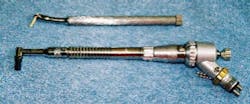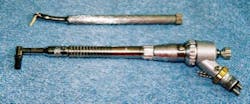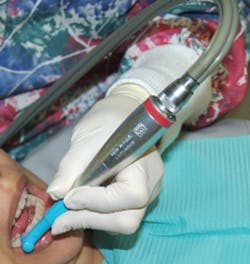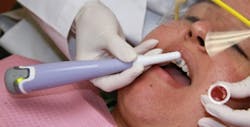Celebrating polishing
From porte polishers to portable polishers
by Anne Nugent Guignon, RDH, MPH
Most people like to celebrate their birthdays. Birthdays are someone's own personal holiday, the one day a year there is no need to apologize when the limelight focuses on you. When I turned 50, I created the birth month concept, where I dedicated an entire month to celebrating! The idea never took off nationally, but birthdays are still unique points of celebration.
Last year, shortly before my 60th, a small package arrived from Debbie Nigh, who received her BSDH from UMKC one year after I did. In the early '70s the program's clinical kits were identical and full of items rarely seen, much less used, in today's world. Debbie's present to me was her Ivory-brand porte polisher! That may seem like a strange gift, or one that would not generate much excitement, but I was genuinely thrilled to have another one of these primitive polishing devices.
Those who have attended one of my CE courses know that I like to pass around my porte polisher and an old heavy Midwest TruTorque handpiece to show dental professionals just how far we've come. My porte polisher proves that critical ergonomic features like a large diameter, textured surface, balanced weight, and contra-angled head were available even way back then. These antiques generate giggles among hygienists who have practiced forever, and amazement among new clinicians who've never seen such old devices. Debbie, thank you for making sure the tradition goes on!
For years, polishing meant nothing more than stain removal. Today's polishing devices are now used for a much wider range of activities, including biofilm disruption prior to ultrasonic scaling, application of desensitizing pastes, and preparing teeth for sealants. In addition, more hygienists are providing services in settings outside of the traditional dental office – long-term care facilities, schools, mobile units, remote mission facilities, homebound patient residences, and locations without traditional air and water hookups.
Early handpiece designs
A look back at history helps us appreciate the amazing advances offered by today's polishing devices. Recent graduates are usually dumbfounded by the lengths seasoned hygienists had to go to in order to remove stain years ago. Early polishing devices were primitive, labor intensive, hard on a clinician's body, and created infection control nightmares. Prior to the invention of the air turbine, there were two polishing modalities – the hand-activated porte polisher, and heavy, belt-driven handpieces fitted with metal prophy angles using latch-type cups.
Handpieces manufactured in the mid '60s were heavy, durable, air-driven devices used for a variety of slow speed activities such as cutting teeth and polishing off stain. Good ergonomic design was never their strong point. Even today, some hygienists are expected to work with handpieces that weigh as much as 9.5 ounces, with most of the weight at the hose end.
Initially, slow-speed handpieces were designed with a long and slender straight profile, which required clinicians to use a strong, fatiguing pinch grip. Little thought was given to ergonomics or the long-term health effects of using these handpieces, which were attached to heavy, coiled air hoses that constantly tugged on the wrist, causing potential stress created by constant contact with a foot-activated rheostat. Thirty years ago, low speed handpiece designs became shorter, but they were still heavy and unbalanced, with the weight concentrated at the motor end.
In the mid '80s, reports surfaced that dental professionals were at risk for developing workplace related musculoskeletal disorders. Ergonomists interested in workplace safety identified clinical dental hygienists at high risk for developing a cumulative trauma disorder. Due to clinical demands, dental hygienists spend their days performing repetitive procedures, often using awkward body movements, tight pinch grips, and excessive force in a confined workspace – the oral cavity.
Clinical practice affects the entire body, but in particular ergonomic stresses from polishing place stress on the musculoskeletal structures of the hand, wrist, forearm, and elbow. Much of the early concerns viewed carpal tunnel syndrome as the biggest threat, but it soon became apparent that clinical practitioners were developing a whole host of conditions directly related to their working environment.
Improving handpiece ergonomics
An important ergonomic criterion for any hand tool is, does the tool fit your hand? By the early '80s, manufacturers increased dental instrument diameters. The transition was gradual, but clinicians soon realized that larger diameter handpieces decreased pinch/grip, resulting in a lighter grasp. This seemingly subtle change improved tactile sensitivity and made it much easier to control handheld dental devices.
As awareness grew, dental equipment designers started to consider additional ergonomic principles. The next logical progression was a polishing handpiece created specifically for the dental hygienist. The Midwest RDH handpiece, introduced in 1996, changed our thoughts about polishing handpieces. The revolutionary tapered profile had a much wider diameter grip at the hose end, which allowed a more relaxed hand position. Clinicians with small hands may prefer Kavo's Prophy Wiz, designed with a slimmer, more tapered body, or shorter handpieces such as the Prophy Star III by DentalEz, Brasseler's Hygiene Pro, or the Denticator Prophy Pal.
Fueled by dental hygienists who embraced these new design concepts, manufacturers and designers turned their attention to creating new and better products that would alleviate the ergonomic stresses faced by hygienists. The majority of polishing handpieces used today are slow-speed devices that hook directly on to an air hose. Swivel mechanisms modify both wrist and hand stress by reducing the negative ergonomic effects of the weight and torque from the air hose. Handpiece designs vary. Swivels are incorporated at the fingertip, the midbody, or as a hose-end design. Examples of handpieces that incorporate smooth swivel mechanisms include Denticator's Prophy Pal, the Midwest RDH, and DentalEz's Prophy Star III.
.Traditional lightweight, swiveling air-driven polishing handpiece uses a contra-angled disposable prophy angle.
Lightweight metals, textured gripping surfaces, and balanced handpiece weight also contribute to clinician comfort. Contemporary handpieces now weigh a mere 2.1 to 3.5 ounces, a dramatic 60% to 80% reduction from those of the 1960s. Texture is also critical. Dentistry involves precision work in a wet environment. It takes more force to hold on to a smooth, wet tool than to a lightly textured surface that provides traction. Polishing handpieces are also made with comfortable silicone texturized fingertip grips. Well-balanced handpieces fit comfortably when supported lightly between the thumb, index, and middle finger, reducing unnecessary musculoskeletal stress.
Cordless technologies lead to new handpieces
Cordless power tools started popping up everywhere a few years ago – from household drills to handheld food mixers. Cordless devices eliminate the hassle of cord weight or torque, and allow individuals to perform tasks in remote and unusual places. As battery technology improved, the possibility of a cordless polishing handpiece moved from the imagination to reality. The challenge lay in creating a cordless device that could deliver sufficient power, stand up to infection control requirements, hold a sufficient charge to make it through the clinical day, and be recharged at night or over a lunch break.
Clinicians using cordless handpieces can maintain a neutral wrist position because they are never forced to accommodate a handpiece hose. The first cordless polisher was introduced over 10 years ago by NSK. The most recent model, the Hygiene Pro, available through Brasseler, features an on/off switch. The speed-control touch pad is incorporated into the handpiece body. Cordless handpieces are much quieter than their air driven counterparts, a factor appreciated by those patients who turn white at the mere sound of a drill.
Discus Dental's new cordless Zen polisher has a unique blend of features for today's clinicians. The lightweight Zen delivers a fluid range of polishing speeds comparable to those found in a corded handpiece, through a comfortable wireless rheostat that is electronically paired in a manner similar to a cell phone/wireless headset interface, and gives the user full control over the cup rotation. A speed control button at the base of the handpiece gives clinicians the option of four distinct speeds rather than using a rheostat.
Infection control and maintenance
Protocols vary for each type of polishing handpiece. Some clinicians use plastic barriers for infection control, and others use self-adhesive barrier products. Self-adhesive barriers can limit the ergonomic benefits of a swivel mechanism, but nonadhesive, plastic barriers create slippery surface interfaces, causing clinicians to have a tighter grasp to maintain control.
Other clinicians rely on spray/wipe/spray procedures rather than a physical barrier. All metal devices can be sterilized in a steam autoclave. Some handpieces are self-lubricating, while others must follow a particular cleaning and lubricating regimen prior to sterilization. Familiarize yourself with individual manufacturers' recommendations to achieve optimal performance and maintain the warranty.
Cordless polishers have internal battery-driven micromotors, electronic components that cause the prophy cup or brush to spin. Electronic devices are moisture sensitive and therefore cannot be autoclaved or submerged in a fluid disinfectant. Moist wipes are also not recommended, since the slightest bit of moisture will damage the electronics. Disposable barrier-protection sleeves are advisable for cordless polishers that may be sensitive to moisture from a wipe. The Zen polisher comes with three innovative and autoclavable protective covers called shells. These unique barriers cover the entire surface that comes in contact with a clinician's gloved hand. Once the barrier shell is removed, the inner surface of the Zen handpiece should be wiped down with an appropriate surface-disinfectant wipe to ensure complete infection control.
All cordless polishers have product-specific charging units and replaceable, rechargeable batteries. The Zen's powerful lithium ion batteries, sealed into the handpiece, provide more torque than previous cordless handpieces and are covered by a two-year extended warranty. Nothing is more annoying than finding out the charge is running low on a device. Getting in the habit of storing the handpiece in the charger at the end of each procedure is a surefire way to avoid disappointment.
The role of prophy angles in polishing ergonomics
A wide assortment of prophy angles, cups, brushes, and polishing points are available for polishing. Disposable prophy angles, originally designed for the hygiene-specific polishing handpieces, dominate the U.S. market. Disposable products weigh one quarter of an all-metal angle, and are fashioned in either classic right angle profiles or contra-angle configurations, which many consider to provide a neutral hand position. Metal angles require time to maintain, so ergonomic issues and time considerations may negate the perceived savings of an autoclavable metal angle.
Prophy angles, used in modern polishing handpieces, slip on smoothly and are held by an internal friction grip mechanism. Once the angle is secure on the handpiece, there is no need to apply more force. The Zen cordless polishing has a unique attachment where the angle snaps smoothly on the handpiece shaft, which creates a secure, seamless handpiece/angle interface.
A few polishing handpieces are designed with a built-in, autoclavable prophy angle head that can accept a variety of cups and brushes. Another way to reduce overall weight is to use an extended disposable angle that fits over either the shaft of some slow-speed polishing motors or a specially designed, lightweight handpiece.
Whether one uses a cup, brush, or point is based on the clinical challenge. However, new hybrid cup designs that feature ribs on the outside of the cup, or a small, soft cup embedded in the center of the cup, make polishing more efficient, especially when used with today's smart polishes that offer superior stain removal with minimal impact on tooth structure. Soft cups conform to complex tooth anatomy without much force, which reduces stress on the hand. Many clinicians believe short profile cups are easier to use in small mouths, and they adapt more readily if the dentition is crowded.
Faster is not better
Polishing handpieces should be operated below 3,000 RPM. Faster is not better since techniques like this can result in gingival abrasion, cause patient discomfort, and result in excessive heat that may damage the pulp. Excessive speed also contributes to premature failure of disposable prophy angles. Handpiece gear mechanisms are designed to function most effectively at lower RPMs and become overheated if used at high speeds. In addition, handpieces operated at high speeds create more prophy paste splatter, which is not only annoying but creates infection control concerns.
Once again advances in technology have given us wonderful new tools to help us preserve our patients' dentitions and cosmetic restorations, reduce the risk of workplace-related injuries, and give patients the dazzling smiles they expect. Today's polishing handpieces are nothing like what we used to use, and are a critical factor in our profession's meeting new challenges in new places to care for patients who deserve the very best.
The author received an educational grant from Discus Dental for preparation of this manuscript.
Anne Nugent Guignon, RDH, MPH, provides popular programs, including topics on biofilms, power driven scaling, ergonomics, hypersensitivity, and remineralization. Recipient of the 2004 Mentor of the Year Award and the 2009 ADHA Irene Newman Award, Anne has practiced clinical dental hygiene in Houston since 1971.
When polishing beganOn Nov. 17, 1913, 32 women began formal training to become dental hygienists in Bridgeport, Conn. Students attended classes three days a week in Dr. Alfred Fones' converted carriage house. Fones enlisted the help of prominent medical and dental specialists and practitioners to teach at the new school. These educational pioneers came from Harvard, Yale, University of Pennsylvania, Columbia College of Physicians and Surgeons, and private practices in New York and Bridgeport. They donated their time and shared a variety of teaching responsibilities with the first class of dental hygienists at the Fones School.
During the first four and a half months, the Bridgeport demonstration project consisted of 52 evening lectures held three evenings a week. The series included topics remarkably similar to those taught today – anatomy and physiology, inflammation, sterilization, nutrition, caries, oral secretions, malocclusion, periodontal disease, deposits and accretions, bacteriology, and even posture and fresh air. A large open room served as the lecture hall, and was later converted to a preclinical classroom outfitted with mannequin heads with rubber tongues and cheeks.
Polishing was the first clinical skill students learned. After five lessons, students took a practical exam proving polishing competency. They were required to remove carpenter's pencil marks from artificial teeth using a porte polisher, orangewood sticks, and moist pumice. Three points were counted off for every pencil mark that was not removed during the 90-minute test.
In April, the students began their six-week clinical training with adult patients. Student Mabel McCarthy wrote a detailed account of their training. At the time, polishing was an exacting procedure, not a quick pass through the mouth with a rubber cup. Twenty-seven women graduated on June 6, 1914. A new profession was born.




